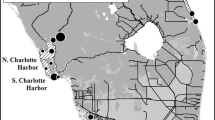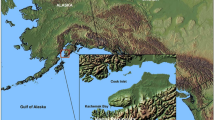Abstract
The St. Thomas East End Reserves or STEER is located on the southeastern end of the island of St. Thomas, USVI. The STEER contains extensive mangroves and seagrass beds, along with coral reefs, lagoons, and cays. Within the watershed, however, are a large active landfill, numerous marinas, resorts, various commercial activities, an EPA Superfund Site, and residential areas, all of which have the potential to contribute pollutants to the STEER. As part of a project to develop an integrated assessment for the STEER, 185 chemical contaminants were analyzed in sediments from 24 sites. Higher levels of chemical contaminants were found in Mangrove Lagoon and Benner Bay in the western portion of the study area. The concentrations of polychlorinated biphenyls (PCBs), dichlorodiphenyltrichloroethane (DDT), zinc, copper, lead, and mercury were above a NOAA Effects Range-Low (ERL) sediment quality guideline at one or more sites, indicating impacts may be present in more sensitive species or life stages. Copper at one site in Benner Bay was above a NOAA Effects Range-Median (ERM) guideline indicating effects on benthic organisms were likely. The antifoulant boat hull ingredient tributyltin (TBT) was found at the third highest concentration in the history of NOAA’s National Status and Trends (NS&T) Program, which monitors the nation’s coastal and estuarine waters for chemical contaminants and bioeffects. The results from this project will provide resource managers with key information needed to make effective decisions affecting coral reef ecosystem health and gauge the efficacy of restoration activities.




Similar content being viewed by others
References
Apeti, D. A., Hartwell, S. I., Johnson, W. E., & Lauenstein, G. G. (2012a). National Status and Trends Bioeffects Program: field methods (p. 52). Silver Spring, MD: NOAA National Centers for Coastal Ocean Science, Center for Coastal Monitoring and Assessment. NOAA NCCOS Technical Memorandum 135.
Apeti, D. A., Whitall, D. R., Pait, A. S., Dieppa, A., Zitello, A. G., & Lauenstein, G. G. (2012b). Characterization of land based sources of pollution in Jobos Bay, Puerto Rico: status of heavy metal concentration in bed sediments. Environmental Monitoring and Assessment, 184, 811–830.
Budzinski, H., Jones, I., Bellocq, J., PiCrard, C., & Garrigues, P. (1997). Evaluation of sediment contamination by polycyclic aromatic hydrocarbons in the Gironde estuary. Marine Chemistry, 58, 85–97.
EPA (U.S. Environmental Protection Agency). 2011. Remediation system evaluation. Tutu Wellfield Superfund Site, St. Thomas, U.S. Virgin Islands. Office of Solid Waste and Emergency Response (5102G). Final Report. EPA-542-R-11-008. 37 pp.
IRF (Island Resources Foundation). 1993. Mangrove Lagoon/Benner Bay area of particular concern (APC) and area for preservation and restoration (APR) management plan: a comprehensive analytic study. Prepared by Island Resources Foundation, St. Thomas, Virgin Islands, for USVI DPNR/CZM Program. 32 pp.
Kimbrough, K. L., & Lauenstein, G. G. (Eds.). (2006). Major and trace element analytical methods of the National Status and Trends Program: 2000–2006 (p. 19). Silver Spring, MD: NOAA Technical Memorandum NOS NCCOS 29.
Kimbrough, K. L., Lauenstein, G. G., & Johnson, W. E. (Eds). 2006. Organic contaminant analytical methods of the National Status and Trends Program: update 2000–2006. NOAA Technical Memorandum NOS NCCOS 30. 137pp.
Libes, S. M. (1992). An introduction to marine biogeochemistry. New York, NY: Wiley. 734 pp.
Long, E. R., MacDonald, D. D., Smith, S. L., & Calder, F. D. (1995). Incidence of adverse biological effects within ranges of chemical concentrations in marine and estuarine sediments. Environmental Management, 19, 81–97.
Long, E. R., & Morgan, L. G. (1990). The potential for biological effects of sediment-sorbed contaminants tested in the National Status and Trends Program (p. WA175). Seattle: NOAA Technical Memorandum NOS OMA 52.
Oros, D. R., & Ross, J. R. M. (2004). Polycyclic aromatic hydrocarbons in San Francisco estuary sediments. Marine Chemistry, 86, 169–184.
Pait, A. S., Whitall, D. R., Jeffrey, C. F. G., Caldow, C., Mason, A. L., Lauenstein, G. G., & Christensen, J. D. (2008). Chemical contamination in southwest Puerto Rico: an assessment of organic contaminants in nearshore sediments. Marine Pollution Bulletin, 56, 580–606.
Pait, A. S., Mason, A. L., Whitall, D. R., Christensen, J. D., & Hartwell, S. I. (2010). Assessment of chemical contaminants in sediments and corals in Vieques. In Bauer and Kendall (Ed.), An ecological characterization of the marine resources of Vieques, Puerto Rico part II: field studies of habitats, nutrients, contaminants, fish, and benthic communities (p. 174). Silver Spring, MD: NOAA Technical Memorandum NOS NCCOS 110.
Pait, A. S., Whitall, D. R., Dieppa, A., Newton, S. E., Brune, L., Caldow, C., Mason, A. L., Apeti, D. A., & Christensen, J. D. (2012). Characterization of organic chemical contaminants in sediments from Jobos Bay, Puerto Rico. Environmental Monitoring and Assessment, 184(8), 5065–5075.
STEER. 2011. St. Thomas East End Reserves management plan. Edited by J. Brown, A. Holecek, J. Murray, L. Noori, J.P. Oriol, J. Pierce, R. Platenberg, S. Romano, D. Russo, & C. Settar. 99 pp.
Strand, J., Jørgensen, A., & Tairova, Z. (2009). TBT pollution and effects in molluscs at US Virgin Islands, Caribbean Sea. Environmental International, 35, 707–711.
Yunker, M. B., Macdonald, R. W., Vingarzan, R., Mitchell, R. H., Goyette, D., & Sylvestre, S. (2002). PAHs in the Fraser River basin: a critical appraisal of PAH ratios as indicators of PAH source and composition. Organic Geochemistry, 33, 489–515.
Acknowledgments
The authors wish to acknowledge the support from NOAA’s Coral Reef Conservation Program (CRCP) for this project. We would also like to thank Jean-Pierre Oriol, Director of the Department of Planning and Natural Resources (DPNR) Division of Coastal Zone Management, Roy Pemberton, Director of DPNR Division of Fish and Wildlife, Jeanne Brown of The Nature Conservancy, Tyler Smith, Sandra Romano, Renata Platenberg, Kevin Brown, and Frank Galdo, Jr. of the University of the Virgin Islands (UVI), and Rob Ferguson and Marlon Hibbert of NOAA’s CRCP for help with the planning, logistics, and fieldwork along with interpretation of results for this project. Sybille Sorrentino of Virgin Island Ecotours graciously provided a base of operations for our fieldwork. Finally, we would like to thank Captain Bobby Vante of the Bright Star for his skill and patience in getting us to the sampling sites within the St. Thomas East End Reserves.
Author information
Authors and Affiliations
Corresponding author
Rights and permissions
About this article
Cite this article
Pait, A.S., Hartwell, S.I., Mason, A.L. et al. An assessment of chemical contaminants in sediments from the St. Thomas East End Reserves, St. Thomas, USVI. Environ Monit Assess 186, 4793–4806 (2014). https://doi.org/10.1007/s10661-014-3738-1
Received:
Accepted:
Published:
Issue Date:
DOI: https://doi.org/10.1007/s10661-014-3738-1




